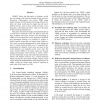Free Online Productivity Tools
i2Speak
i2Symbol
i2OCR
iTex2Img
iWeb2Print
iWeb2Shot
i2Type
iPdf2Split
iPdf2Merge
i2Bopomofo
i2Arabic
i2Style
i2Image
i2PDF
iLatex2Rtf
Sci2ools
VR
2002
IEEE
2002
IEEE
A Scalable, Multi-User VRML Server
VRML97 allows the description of dynamic worlds that can change with both the passage of time, and user interaction. Unfortunately, the current VRML usage model prevents its full potential from being realized. Initially, the whole world must be loaded into the user’s desktop browser, and so large worlds can take a very long time to download and render, while a world cannot be shared among multiple users This paper describes the design and implementation of a client-server architecture that was built to overcome these problems. The major novelty is the decoupling of VRML world execution from world rendering. Parallelism and information filtering are exploited to produce a highly scalable system that can support huge, highly active worlds, accessed simultaneously by large numbers of users. A cluster-based parallel server is responsible for maintaining the dynamic world state, and most of the world dynamics are evaluated on the server side. The server streams VRML to the client, using ...
| Added | 16 Jul 2010 |
| Updated | 16 Jul 2010 |
| Type | Conference |
| Year | 2002 |
| Where | VR |
| Authors | Thomas Rischbeck, Paul Watson |
Comments (0)

